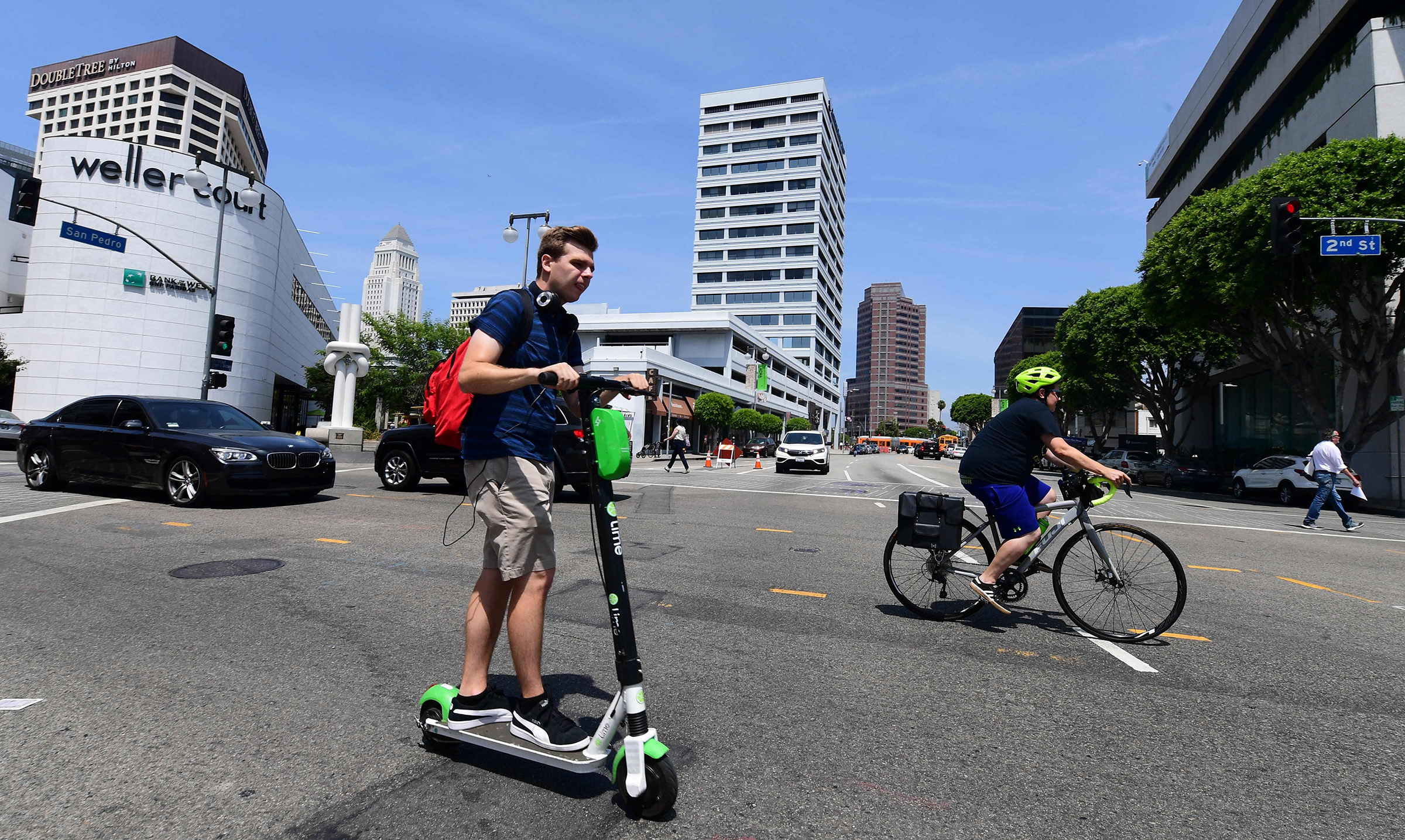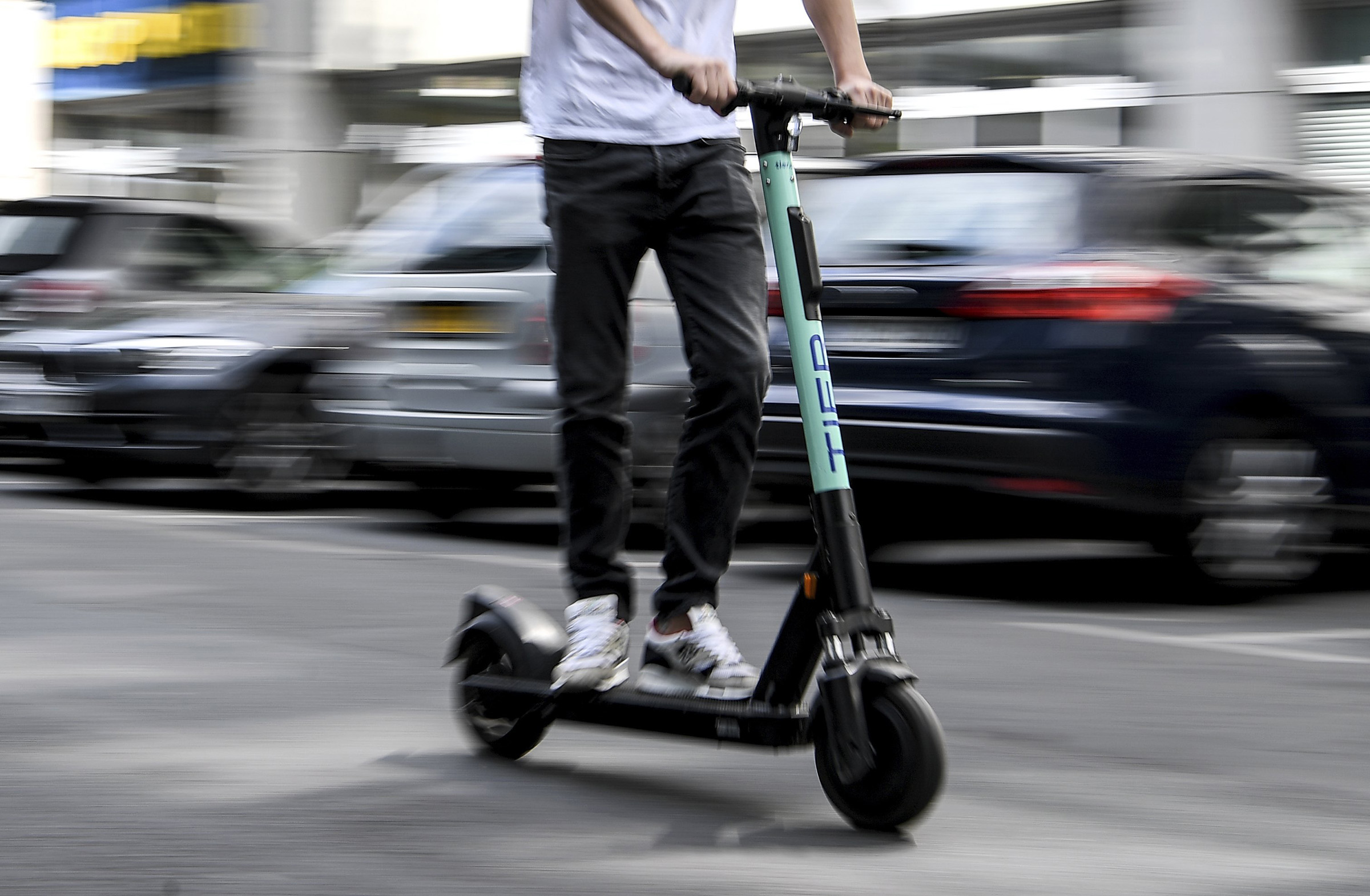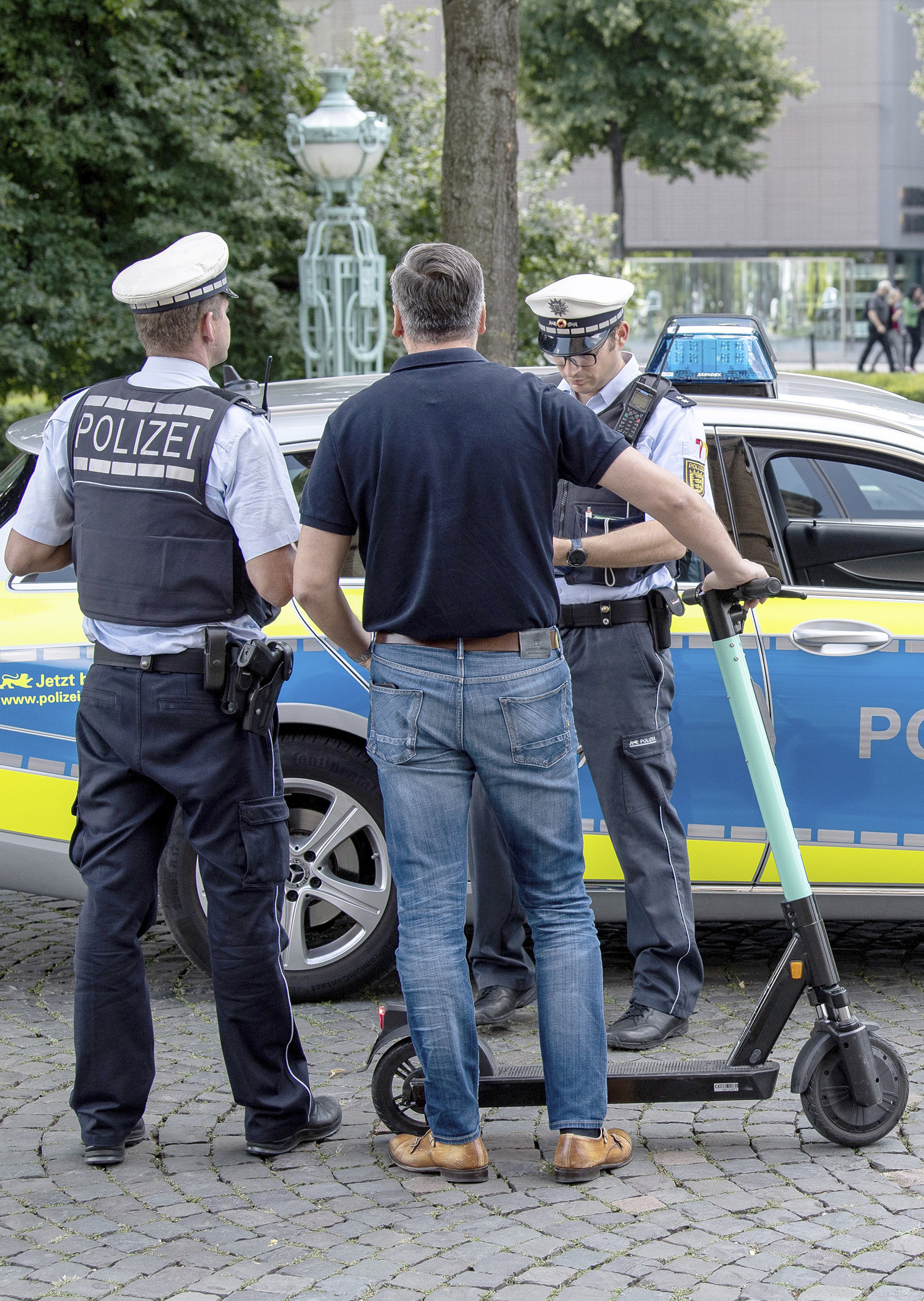
It was five o’clock on a recent Monday afternoon, and at one of the busiest connectors between the city’s center and its surrounding neighborhoods, rush hour was in full swing. Hundreds of vehicles flowed across Dronning Louise’s bridge every minute, but this being Copenhagen, the vast majority of them–some 48,000 by day’s end– were bicycles, not cars. Among the surging tide of cargo bikes, fixies, and plain, old-fashioned two-wheelers, two tourists stood upright on e-scooters, their uncertain weaving prompting a few angry chimes from passing bike bells. From the sidewalk, Marie Djernes, a 24-year-old student who was standing next to her own bike as she waited for a friend, watched the scene with bemusement. “Yeah, they’re a bit annoying,” she said. “They don’t really seem to know what they’re doing.”
Bird, Lime, Circ, Tier, Dott, Voi, Volo, Scoot, Trotti, Poppi: since making their first appearance in California in 2017, electric scooters with names that sound like modern-day versions of Snow White’s dwarves have popped up in over 100 cities worldwide, the progeny of companies aiming to become the next Uber of alternative transport (that includes Uber itself, which, despite having recently posted $5.2 billion in losses, has its own line of e-scooters, Jump). Yet for all its success, this new form of “micromobility,” as its promoters love to call it, has also brought a slew of problems, from safety risks to impassable sidewalks. The solution, say many scooter advocates in the U.S. and Europe, lies in creating the kind of infrastructure—wide bike lanes, ample parking— found in cycling-friendly cities like Copenhagen and Amsterdam. But as those cities are themselves learning, e-scooters and bikes don’t necessarily play well together either.
It’s not hard to understand the appeal of electric scooters. For a commuter arriving by train from the suburbs, already late and facing a half mile slog on foot to the office, or a tourist with only a day in a city and a lot of ground to cover, the devices present an easy solution: download the app, add credit card information, unlock one of the seeming gazillions of scooters parked nearby, and off you go. Because they are dockless, the devices can be left anywhere, and because they run on electric batteries instead of fossil fuels, they allow users to feel good about making a climate-friendly choice. And most of all, as their heavy use among the young suggests, zipping through a city on an e-scooter is just plain fun.
But safety is a growing concern. Collisions with both cars and pedestrians have sent thousands of e-scooter users and their unwitting victims to hospitals; one study, conducted by the Centers for Disease Control for the city of Austin, Texas found roughly 20 injuries per 100,000 rides, with half of those considered serious. Scooters have also been implicated in deaths in Paris, London, San Diego, Singapore, and Barcelona, among other cities. On August 9, following four fatalities within three months, Atlanta banned their use at night. A few days later, a French organization representing 60 or so citizens injured in e-scooter collisions announced plans to sue the Paris authorities for negligence in protecting pedestrians.

With an estimated 20,000 trotinettes on its streets–many of them ridden on sidewalks, abandoned in heaps in city squares, or tossed into the Seine–it’s no wonder that Paris’s situation was described as “anarchy” earlier this summer by its once e-scooter friendly mayor Anne Hidalgo. But with regulations varying from country to country, and even city to city, and with an ever growing number of companies placing as many devices as they can in as many cities as possible (Madrid alone has authorized 18 different operators) in an attempt to achieve market dominance, the chaos–and the risks–seem to be growing.
At least one solution to this Wild West situation is better infrastructure, say advocates. In a safety report it released in April, the California-based e-scooter company Bird, with a presence in over 100 cities from Los Angeles to Tel Aviv, noted that it sends helmets to users who request them, but called on the cities themselves to “design for safety.” Bike lanes and similar infrastructure investments, the report stated, “effectively reduce crash risk for all road users.” Maxim Romain, the CEO and co-founder of the Amsterdam-based e-scooter company Dott, agrees. “We work closely with the municipality to invest in infrastructure,” he says of the Dutch company, which currently operates in Belgium, France, and Italy, but hopes to expand to its home country as well. “Like everybody else, at first we put ours on the sidewalk because that’s where we could [station them]. But now, we only deploy them in the parking spaces that each municipality advises. And we’re helping to open 2500 more parking spaces for shared e-scooters.”
In places like San Francisco and London, pro-e-scooter groups have found common cause with cyclists. In July, a television presenter died when the electric scooter she owned collided with a truck at the same south London roundabout where a cyclist was killed in 2018. Although the vehicles are currently banned in London, the city is reviewing their status, and recently met with representatives from Bird and Lime. Rachel White, head of policy for Sustrans, a U.K. cycling advocacy group recently told The Guardian,“Generally, another group of organizations lobbying for improved cycleways can only be a good thing.” And the popularity of the devices–as well as their risks–can alter infrastructure in a way that bikes never have: on Sunday, Atlanta mayor Keisha Lance Bottoms promised in an editorial for the Atlanta Journal-Constitution that the city would put temporary barriers and painted lanes in place to separate e-scooters and bikes from automobile traffic.
Yet some cities with that kind of infrastructure already in place are discovering that a strong cycling culture isn’t necessarily compatible with shared e-scooters either. In Copenhagen, for example, where half of all trips to work or school are made by bike, the reception has been decidedly mixed. “Egypt had 10 plagues. Copenhagen has only one,” complained Berlingske newspaper’s culture editor Anne Sophie Hermansen, in reference to e-scooters which, she wrote “tyrannize traffic” and “look ridiculous.” On Twitter, the hashtag #løbehjulsgate–or ‘e-scootergate,’ has been popping up all summer to refer to the controversy the devices have generated.
Some of the resentment stems from the scooter company’s appropriation of the city’s public furniture. “As a cyclist in Copenhagen you feel taken into consideration, that the city has built a proper space for you,” says Klaus Bondam, director of the Danish Cyclists Federation. “There’s a democratic sense that has been built into the urban streetscape over several generations. That’s basically being disrupted at the moment; [e-scooters] don’t fit into our democratic model of how we use the urban space.”
And that space can get crowded. “We have one of the largest cycling capacities anywhere,” says Mikkel Halby Mindegaard, head of the Streetlife Division for the city of Copenhagen. “But we’re seeing congestion on some streets from e-scooters. And we don’t have sufficient parking infrastructure even for bikes. The scooters add a lot on top of that.”
In Münster, Germany, where bikes outnumber citizens 2 to 1, the municipal government has thus far limited the pressure on infrastructure through regulation and careful selection. Shared e-scooters were first allowed onto streets on July 27–but only 200 of them. After a trial period, that number will double, but all of them will be provided by the Berlin-based company Tier, which collects their entire fleet each night, and puts it out again in the morning–a measure that ensures the scooters are not left randomly parked in thoroughfares or heaped on sidewalks. “We had a lot of problems with share bikes before,” says traffic planner Andreas Pott, “We learned from that.”

Bike-friendly Amsterdam has taken a different tack. The Dutch city has over 400 miles of cycle paths and bike lanes, but with nearly half the population traveling by bicycle each day, some of those pathways have become dangerously crowded. Even before the advent of e-scooters, a 2016 report from the Institute for Road Safety Research found that bottlenecks along the busiest paths were already increasing the number of crashes. In an attempt to ease the pressure, the Dutch government recently forced mopeds, previously allowed in bike paths, into the road with cars. E-scooters, however, fall under earlier legislation, originally drafted for Segways, that requires motorized vehicles to come equipped with air tires and double brakes, before they can be certified for public use in bike lanes. Thus far, no manufacturer has met the requirements.
Even if they do, it’s not clear the Dutch will take to them. “I don’t think Amsterdam is very interested in changing the current situation,” says Maud de Vries, cofounder and managing director of BYCS, an Amsterdam-based organization that promotes cycling. “There’s not enough space for bikes as it is. And with their speed difference, the accidents, and the environmental impact, a lot of people just don’t see the advantages of them.”
Closer scrutiny has called into question some of the e-scooter’s self-branding as a green transportation solution. For one thing, they don’t last very long. Because of their lightweight design and the heavy usage to which they are subjected, Bird and Lime scooters in Louisville and Indianapolis last a mere 28 days on average, with only a handful making it past the two-month mark. Even the hardiest claims — CEO Romain, for example, says Dott’s scooters average just one year — pale in comparison to the average bike’s life cycle.
If their disposability casts doubt on e-scooters’ environmental credentials, so too does their carbon footprint. A life-cycle impact study (which includes an assessment not only of carbon emitted while the device is in use, but also that released by manufacturing, transporting, and charging the vehicles and their batteries), conducted by scientists at North Carolina State University and published earlier this month in the journal Environmental Research Letters found that although e-scooters had less than half the total emissions of cars (202 grams of carbon dioxide per mile traveled for the former vs. 414 grams for the latter), their output was still dramatically higher than that of bicycles,whose life-cycle emissions only average 8 grams per mile.
And while e-scooters do indeed offer an attractive alternative to automobiles (34% of riders surveyed said they would have made the trip by car had the devices not been available), the same study, conducted in Raleigh, North Carolina, shows that with an even higher percentage–49%–would have walked or biked. Those proportions roughly coincide with findings from Portland, Oregon’s bureau of transportation, which, in its own 2018 study, concluded that 45% of e-scooter rides would have been been made on foot or by bike.
“Of course, moving people away from cars is a positive thing,” says Mindegaard. “But we have no hard evidence that e-scooters are doing that. We don’t have numbers yet on where the customers are coming from, but we know that tourists use them a lot, and young people. So it seems like [e-scooter riders] are probably coming from people who would have walked or biked than from people in cars.”

Technically, e-scooters are currently illegal in Denmark, because national law requires any object placed in public space for commercial purposes to be licensed and no company has received a permit yet. But Lime, Voi, Tier and many others “moved into the streets before we got them through the permit process,” says Mindegaard, “It all happened so fast, and they grew so quickly that we didn’t see it coming.” The city of Copenhagen is currently conducting a pilot program that will grant permits for 200 e-scooters stationed in the historic city center, and another 3000 in the outlying neighborhoods. But in the meantime, many companies are blithely operating anyway because the legal requirements for enforcing the ban are complicated enough that police, who, according to Mindegaard, cite limited resources, don’t ticket them.
They do, however, go after drunk e-scooter riders. After a report came out noting that since January, over 100 people had sustained injuries from e-scooters severe enough to send them to the region’s hospitals, Copenhagen police began ticketing users found riding under the influence. But safety remains a concern, as does the broader impact on health. In the greater Copenhagen area, where the number of sick days is reduced by one for every 745 miles cycled, there is concern among cycling advocacy groups like the Danish Cycling Federation that switching to passive e-scooters will result in more obesity and related diseases.
All of those concerns–health, safety, the imposition on public infrastructure—are on activist Yael Bassan’s mind every day when she moves the e-scooters that inevitably crowd the area around her shop–and posts images to social media of herself doing it. But as the owner of Copenhagen Bicycles, she has an added worry: economic survival. Located in the picturesque neighborhood of Nyhavn, one of the city’s most popular tourist destinations, her bike rental business is losing what she estimates to be 5-10% a year to e-scooters, a decline that began last year. “Every scooter that takes one of my customers is 100 kroners I don’t get,” she says. “If there are 30 of those a day, that’s 3000 kroner a day, 30,000 a month, a quarter million in half a year.”
There are roughly 300 bike shops in Copenhagen, and most of them also supply rentals; anecdotal information from a few owners confirms that they too are seeing revenues fall. But what is especially galling, Bassan says, is to lose money to companies so actively flouting the law. “I applied to get permission to put my bikes in the square in front of my shop, and was told it wasn’t possible,” she says. “If I put my bikes there, I’ll get a fine. But every day, there are 20 or more scooters parked there, trying to take my customers, and no one does anything. That’s why I started getting angry.”
Since she started posting videos and photos of herself moving the scooters on Twitter, she’s gotten a lot of support from other Copenhageners tired, she says, of having to dodge the devices on sidewalks and in bike lanes. “Disruption is supposed to be such a positive thing these days. People are afraid to be annoyed at disruption because it makes you sound old or old-fashioned. But we need to ask, do we want this disruption? Is it good for us?”
At the Danish Cycling Federation, director Klaus Bondam is wondering the same thing. Although he himself feels comfortable sharing lane space with e-scooters (“We go about the same speed,” he says with a smile), he knows that isn’t the case for seniors or parents with small children. He worries that those groups will simply stop cycling, just as he worries about the impact on Copenhagen life if public space succumbs to private businesses. “We’ve built a really good bicycle culture in Denmark,” he says. “Ruining that would be a terrible thing.”
More Must-Reads from TIME
- Cybersecurity Experts Are Sounding the Alarm on DOGE
- Meet the 2025 Women of the Year
- The Harsh Truth About Disability Inclusion
- Why Do More Young Adults Have Cancer?
- Colman Domingo Leads With Radical Love
- How to Get Better at Doing Things Alone
- Michelle Zauner Stares Down the Darkness
Contact us at letters@time.com